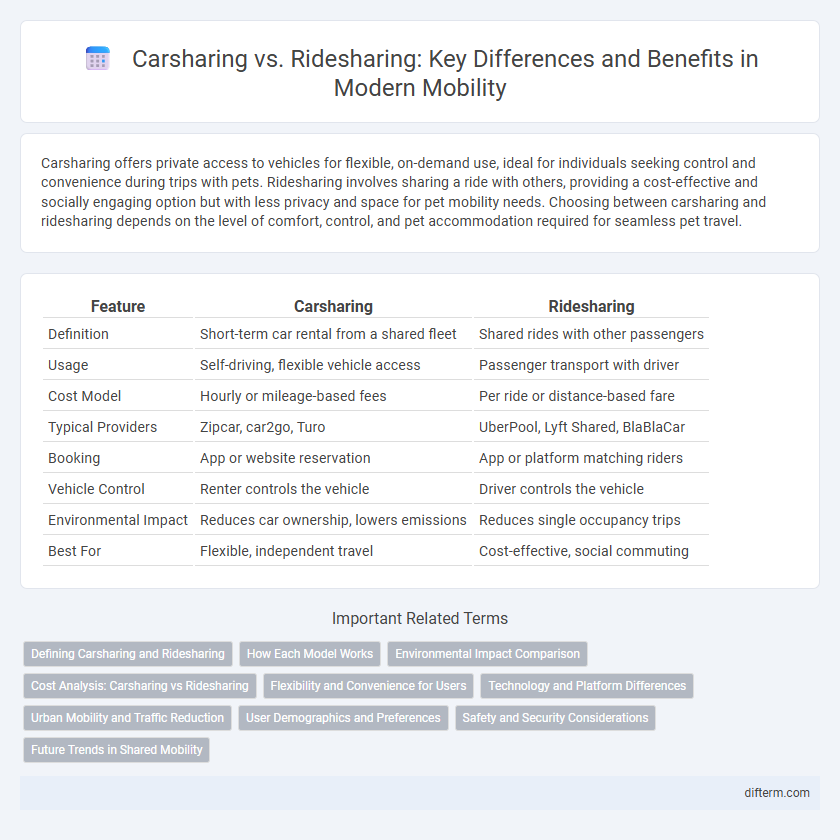Carsharing offers private access to vehicles for flexible, on-demand use, ideal for individuals seeking control and convenience during trips with pets. Ridesharing involves sharing a ride with others, providing a cost-effective and socially engaging option but with less privacy and space for pet mobility needs. Choosing between carsharing and ridesharing depends on the level of comfort, control, and pet accommodation required for seamless pet travel.
Table of Comparison
| Feature | Carsharing | Ridesharing |
|---|---|---|
| Definition | Short-term car rental from a shared fleet | Shared rides with other passengers |
| Usage | Self-driving, flexible vehicle access | Passenger transport with driver |
| Cost Model | Hourly or mileage-based fees | Per ride or distance-based fare |
| Typical Providers | Zipcar, car2go, Turo | UberPool, Lyft Shared, BlaBlaCar |
| Booking | App or website reservation | App or platform matching riders |
| Vehicle Control | Renter controls the vehicle | Driver controls the vehicle |
| Environmental Impact | Reduces car ownership, lowers emissions | Reduces single occupancy trips |
| Best For | Flexible, independent travel | Cost-effective, social commuting |
Defining Carsharing and Ridesharing
Carsharing enables users to rent vehicles for short-term use, typically by the hour or day, providing flexibility and access without ownership. Ridesharing involves multiple passengers sharing a single vehicle journey, often arranged through digital platforms, to reduce costs and environmental impact. Both models enhance urban mobility by promoting resource efficiency and decreasing reliance on private cars.
How Each Model Works
Carsharing enables users to rent vehicles for short periods, typically by reserving through an app and accessing cars located at designated spots, promoting flexibility and cost-efficiency for occasional use. Ridesharing involves matching passengers with drivers already traveling to similar destinations, often coordinated via platforms like Uber or Lyft, optimizing vehicle occupancy and reducing the number of cars on the road. Both models contribute to sustainable urban mobility by minimizing private car ownership and lowering traffic congestion.
Environmental Impact Comparison
Carsharing significantly reduces carbon emissions by decreasing the total number of vehicles on the road, leading to lower energy consumption per trip compared to individual car ownership. Ridesharing optimizes vehicle occupancy, which cuts down on emissions per passenger mile but may generate detours that partially offset environmental benefits. Studies indicate that carsharing programs can reduce greenhouse gas emissions by up to 40%, while ridesharing offers a 20-30% reduction depending on route efficiency and vehicle type.
Cost Analysis: Carsharing vs Ridesharing
Carsharing typically involves fixed hourly or daily rates that cover vehicle use, insurance, and fuel, making it cost-effective for short trips or occasional use. Ridesharing costs fluctuate based on distance and demand, often including surge pricing during peak times, which can increase expenses for frequent travelers. For urban commuters with unpredictable schedules, carsharing may offer greater financial control, while ridesharing appeals to those seeking convenience without vehicle ownership.
Flexibility and Convenience for Users
Carsharing offers users the flexibility to pick up and drop off vehicles at various locations, allowing for spontaneous travel without the need for a driver. Ridesharing provides convenience by enabling users to share rides with others, reducing costs and environmental impact while avoiding parking and driving responsibilities. Both models enhance urban mobility by catering to different needs for flexible, on-demand transportation solutions.
Technology and Platform Differences
Carsharing platforms provide users with on-demand access to vehicles parked nearby, using GPS tracking and mobile apps to enable seamless vehicle reservations and automated check-in/check-out processes. Ridesharing services rely on sophisticated matching algorithms and real-time traffic data to connect passengers with drivers for shared trips, optimizing route efficiency and reducing wait times. While carsharing emphasizes vehicle availability and user autonomy, ridesharing prioritizes dynamic passenger-driver coordination through AI-driven dispatch systems.
Urban Mobility and Traffic Reduction
Carsharing offers urban residents flexible access to vehicles without ownership, significantly reducing the number of privately owned cars and easing parking demand. Ridesharing platforms optimize existing trips by matching multiple passengers heading in similar directions, lowering overall vehicle miles traveled and congestion. Together, these models contribute to sustainable urban mobility by decreasing traffic density and emissions in city environments.
User Demographics and Preferences
Carsharing primarily attracts urban professionals aged 25 to 40 who value flexibility and short-term vehicle access without ownership costs, while ridesharing users often span a broader demographic including students and occasional travelers seeking convenience and cost savings. Preferences in carsharing emphasize vehicle variety, ease of reservation, and proximity to pick-up locations, whereas ridesharing users prioritize real-time availability, ride cost, and driver ratings. Understanding these distinct user demographics and preferences helps tailor mobility services to improve adoption rates and customer satisfaction within each segment.
Safety and Security Considerations
Carsharing services implement rigorous vehicle maintenance protocols and driver verification processes to ensure user safety, reducing risks of accidents and mechanical failures. Ridesharing platforms prioritize real-time driver tracking, background checks, and in-app emergency assistance features to enhance passenger security during trips. Both models tackle privacy concerns with encrypted data handling and user authentication, fostering trust in shared mobility environments.
Future Trends in Shared Mobility
Carsharing services are evolving with innovations in electric and autonomous vehicles, offering users more flexibility and sustainability compared to traditional ridesharing. Integration of AI-driven platforms enhances real-time demand prediction and route optimization, reducing operational costs and environmental impact. Future trends indicate a convergence of carsharing and ridesharing models, supported by smart city infrastructure and multimodal transportation networks.
carsharing vs ridesharing Infographic

 difterm.com
difterm.com